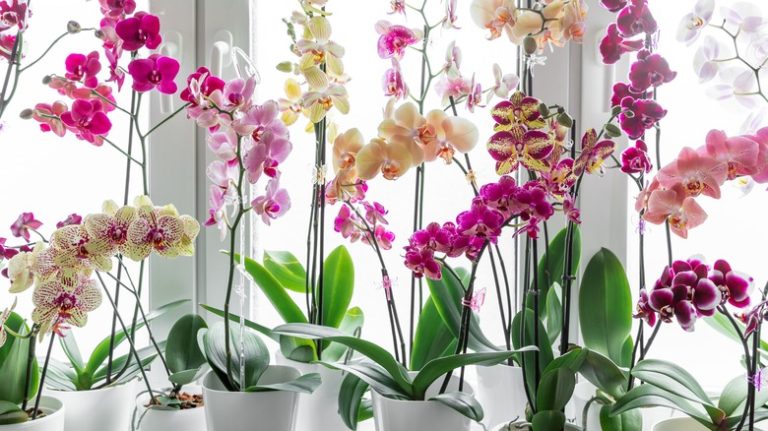Boneset (Eupatorium perfoliatum) is a large and spreading native plant that has been a staple in gardens for centuries. Found primarily in the eastern United States, boneset is a member of the Asteraceae family and is renowned for its ornamental value and captivating flowers.
Also known as thoroughwort, boneset is a perennial herb that can reach a height of up to three feet. The plant’s leaves are perfoliate, meaning that the stems appear to run directly through the leaves, giving a unique and distinctive appearance. The leaves are light green and have prominent veins that give a three-lined look.
Boneset blooms in late summer to early fall, attracting a variety of pollinators such as bees, butterflies, and moths. Its flowers are small and white, forming clusters at the top of the plant. The nectar-rich flowers are a valuable resource for pollinators, and their attraction to boneset adds interest and diversity to any garden.
Boneset is a fairly low-maintenance plant, tolerating a range of soil types and moisture conditions. It is most commonly found in moist soils, such as along streams or in wetlands, but it can also grow well in drier soils. This adaptability makes boneset a versatile addition to any garden or landscape.
In terms of pests and diseases, boneset is relatively resistant. It is not commonly attacked by pests or diseases, although it may occasionally be affected by borers or beetles. With proper organic management and cultivation practices, boneset can thrive without any major pest issues.
If you are looking to add native plants to your garden, boneset is a fantastic choice. Its attractive foliage, stunning flowers, and versatility make it a desirable plant for any garden setting. Whether you are a beginner gardener or an experienced horticulturist, boneset is sure to provide content and interest throughout the year.
So why not consider adding boneset to your garden? With its beauty, adaptability, and ecological value, this native plant is a true king in the sunflower family.
Boneset is a Thoroughly Valuable Native Plant
Boneset (Eupatorium perfoliatum) is a native plant that has been valued for its medicinal properties for centuries. It is a herbaceous perennial that can reach heights of 3 to 6 feet, with large clusters of white flowers that bloom from late summer to early fall. The plant is fairly widespread in the eastern United States and can be found in a variety of habitats, including bogs and wetlands.
This plant has been of interest to natural resource managers because it is a valuable source of nectar and pollen for pollinators, particularly butterflies and bees. In fact, the three-lined butterfly (Pontia protodice) has been observed feeding on the flowers of boneset. The plant also provides habitat for a variety of insects, including the boneset borer and beetles.
Not only is boneset attractive to pollinators, but it also has cultural and historical significance. Native American tribes have long used boneset in their traditional medicine practices, and it has been noted for its use in religious ceremonies. European settlers in America also recognized the medicinal properties of boneset and used it to treat a variety of ailments.
One of the most valuable aspects of boneset is its ability to help manage wetland habitats. The plant has a deep root system that helps stabilize the soil and prevent erosion. It also helps filter and purify water, making it an important component of natural wetland systems.
In addition to its ecological benefits, boneset has practical uses as well. The plant has been used as a natural remedy for fevers, colds, and digestive issues. It is also said to have anti-inflammatory and pain-relieving properties.
As interest in organic gardening and native plants has grown, boneset has become an increasingly popular choice for home gardens and landscaping. It is relatively easy to grow and requires little maintenance. It prefers full sun to light shade and moist, well-draining soil. Boneset is also hardy in zones 3 to 9, making it suitable for a wide range of climates.
If you are interested in adding boneset to your garden or landscape, it is readily available from nurseries and plant-shipping services. You can also find seeds and plants from online retailers. When planting boneset, keep in mind that it can spread fairly easily, so it is important to give it enough space to grow.
In conclusion, boneset is a valuable native plant that offers a variety of benefits to both humans and the natural environment. Its attractive flowers, historical significance, and ecological value make it a worthy addition to any garden or landscape.
Boneset
Boneset, also known by its Latin name Eupatorium perfoliatum, is a native plant that can be found in various habitats across North America. It is a perennial plant that belongs to the sunflower family, and it is known for its clusters of small, white flowers.
One of the standout features of boneset is its height, which can reach up to six feet. The plant has long, narrow leaves that are perfoliate – meaning that the stem appears to go through the leaves.
During the late summer and early fall, boneset becomes a valuable source of nectar for pollinators, including bees, moths, and butterflies. The flowers are also attractive to beetles and other insects.
Boneset is often grown in home gardens, as it adds interest and color to the landscape. It thrives in moist soil and full sun, but it can also tolerate some shade. The plant is fairly adaptable and can grow in a wide range of hardiness zones.
In addition to its aesthetic value, boneset provides important services within the ecosystem. The plant attracts pollinators, which help to fertilize nearby plants and support their reproduction. Its deep root system also helps to stabilize soil and prevent erosion.
Boneset has a long history of medicinal use. Native Americans used it to treat a variety of ailments, including fevers, gastrointestinal issues, and respiratory problems. In the 19th century, boneset became popular in Europe and was even called “King of the Fever Plants” for its ability to reduce fevers.
Today, boneset is still used in herbal medicine practices. The plant contains compounds that have been shown to have anti-inflammatory and immune-stimulating properties. It is often used to treat colds, flu, and other respiratory infections.
In conclusion, boneset is a versatile and valuable plant. Its attractive flowers and height make it a great addition to gardens, and its role as a nectar source for pollinators helps to support local ecosystems. Whether for its aesthetic or medicinal properties, boneset has a long history of capturing the interest of gardeners and herbalists alike.
MSU Extension Native Plants and Ecosystem Services
Native plants play a crucial role in supporting ecosystems and providing a variety of services. One such plant is the Boneset (Eupatorium perfoliatum), also known as the thoroughwort or agueweed. This sunflower-relative is of great interest to both gardeners and ecologists.
Boneset typically grows in moist habitats, standing out with its height of up to 6 feet and width of 3 feet. Its white flowers, which bloom from late summer to early fall, attract plenty of pollinators, making it a valuable source of nectar and pollen for bees, butterflies, and other insects.
Native to eastern states in the US, the Boneset seems to prefer organic-rich soils, although it can tolerate a range of soil conditions. It is a fairly hardy plant that can withstand wind and is often used in erosion control and habitat management.
Within the cultivated garden, Boneset makes an excellent companion plant. Its tall stature and conspicuous flowers can serve as a backdrop for smaller or more delicate plants, adding visual interest to the landscape.
For those interested in adding Boneset to their gardens or restoration projects, MSU Extension provides valuable information and resources. They offer plant-shipping services and can provide advice on the cultivation and management of these valuable plants.
In addition to being an attractive and beneficial addition to gardens, Boneset also has a long history of medicinal use. Its Latin name, Eupatorium, refers to King Mithridates Eupator, who was famous for his herbal knowledge. The plant was used to treat fevers and other ailments in the 18th century. However, it is important to note that modern-day use of Boneset for medicinal purposes should be done under the guidance of a healthcare professional.
Overall, Boneset is a stand-out plant that attracts pollinators, adds visual interest to gardens, and provides ecosystem services. Its valuable role in supporting native plant communities and managing habitats makes it a sought-after species for restoration and conservation efforts.
Pollinators attracted
Boneset is a native plant in the United States and is known for attracting pollinators. Its flowers are a national favorite for pollinators, including bees, butterflies, and other insects. One of the most common pollinators attracted to boneset is the three-lined borer bee, which is also known as the Pontus borer bee.
The flowers of boneset are a valuable source of nectar for pollinators during the summer months. Their light pink color and conspicuous veins make them a popular choice for pollinators. This shows that these plants have evolved to attract pollinators to ensure the reproduction of their species. In addition, the tall stems of boneset, which can reach up to six feet in height, provide a good perch for pollinators to rest and feed.
The perfoliate leaves of boneset create a unique look that attracts pollinators. The leaves seem to surround the stems, giving the plant a distinct appearance. This feature is where the plant gets its Latin name, Eupatorium perfoliatum, which translates to “through the leaf.”
Boneset is fairly easy to grow and is often used in gardens as a natural companion plant. It is tolerant of a wide range of soil types and moisture levels, although it does prefer more moisture than some other plants. In cultivation, boneset can be propagated through seed or by dividing established plants.
For garden management, it is recommended to order organic plant-shipping in order to ensure the health of the ecosystem. Boneset can also be a valuable addition to native plant gardens, providing plenty of nectar and habitat for pollinators. By planting boneset together with smaller plants, they can create a diverse and thriving pollinator-friendly garden.
Overall, boneset’s ability to attract pollinators makes it a popular and valuable plant for anyone interested in supporting pollinators and maintaining a healthy ecosystem.




